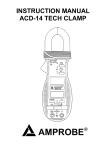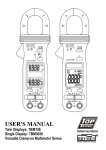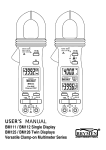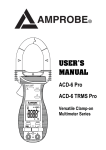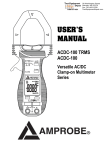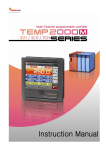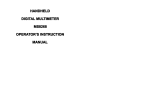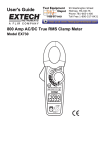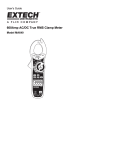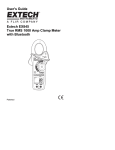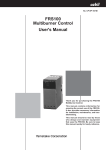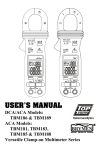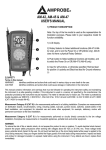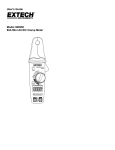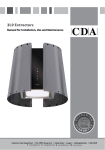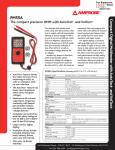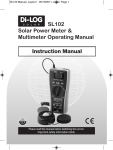Download ACD-14 FX and ACD-14 TRMS FX Digital Clamp-On
Transcript
ACD-14 FX ACD-14 TRMS FX User Manual • Bedienungshandbuch • Mode d’emploi • Manuale d’Uso • Manual de uso • Bruksanvisning Owner’s Manual ACD-14 FX ACD-14 TRMS FX Limited Warranty and Limitation of Liability Your Amprobe product will be free from defects in material and workmanship for 1 year from the date of purchase. This warranty does not cover fuses, disposable batteries or damage from accident, neglect, misuse, alteration, contamination, or abnormal conditions of operation or handling. Resellers are not authorized to extend any other warranty on Amprobe’s behalf. To obtain service during the warranty period, return the product with proof of purchase to an authorized Amprobe Test Tools Service Center or to an Amprobe dealer or distributor. See Repair Section for details. THIS WARRANTY IS YOUR ONLY REMEDY. ALL OTHER WARRANTIES WHETHER EXPRESS, IMPLIED OR STAUTORY - INCLUDING IMPLIED WARRANTIES OF FITNESS FOR A PARTICULAR PURPOSE OR MERCHANTABILITY, ARE HEREBY DISCLAIMED. MANUFACTURER SHALL NOT BE LIABLE FOR ANY SPECIAL, INDIRECT, INCIDENTAL OR CONSEQUENTIAL DAMAGES OR LOSSES, ARISING FROM ANY CAUSE OR THEORY. Since some states or countries do not allow the exclusion or limitation of an implied warranty or of incidental or consequential damages, this limitation of liability may not apply to you. Repair All test tools returned for warranty or non-warranty repair or for calibration should be accompanied by the following: your name, company’s name, address, telephone number, and proof of purchase. Additionally, please include a brief description of the problem or the service requested and include the test leads with the meter. Non-warranty repair or replacement charges should be remitted in the form of a check, a money order, credit card with expiration date, or a purchase order made payable to Amprobe® Test Tools. In-Warranty Repairs and Replacement – All Countries Please read the warranty statement and check your battery before requesting repair. During the warranty period any defective test tool can be returned to your Amprobe® Test Tools distributor for an exchange for the same or like product. Please check the “Where to Buy” section on www.amprobe.com for a list of distributors near you. Additionally, in the United States and Canada In-Warranty repair and replacement units can also be sent to a Amprobe® Test Tools Service Center (see address below). Non-Warranty Repairs and Replacement – US and Canada Non-warranty repairs in the United States and Canada should be sent to a Amprobe® Test Tools Service Center. Call Amprobe® Test Tools or inquire at your point of purchase for current repair and replacement rates. In USA Amprobe Test Tools Everett, WA 98203 Tel: 877-AMPROBE (267-7623) In Canada Amprobe Test Tools Mississauga, ON L4Z 1X9 Tel: 905-890-7600 Non-Warranty Repairs and Replacement – Europe European non-warranty units can be replaced by your Amprobe® Test Tools distributor for a nominal charge. Please check the “Where to Buy” section on www.amprobe.com for a list of distributors near you. European Correspondence Address* Amprobe® Test Tools Europe P.O. Box 1186 5602 BD Eindhoven The Netherlands *(Correspondence only – no repair or replacement available from this address. European customers please contact your distributor.) ACD-14 FX ACD-14 TRMS FX Contents: Safety Regulations...............................................................................................................................3 Product Description.............................................................................................................................5 Operation.............................................................................................................................................6 Maintenance.......................................................................................................................................12 Specifications......................................................................................................................................14 Congratulations! Your new instrument has been crafted according to quality standards and contains quality components and workmanship. It has been inspected for proper operation of all of its functions and tested by qualified factory technicians according to the long-established standards of Amprobe. Safety Regulations This manual contains information and warnings that must be followed for operating the instrument safely and maintaining the instrument in a safe operating condition. If the instrument is used in a manner not specified by the manufacturer, the protection provided by the instrument may be impaired. OVERVOLTAGE CATEGORY III: Equipment of OVERVOLTAGE CATEGORY III is equipment in fixed installations. Note – Examples include switches in the fixed installation and some equipment for industrial use with permanent connection to the fixed installation. TERMS IN THIS MANUAL WARNING: Identifies conditions and actions that could result in serious injury or even death to the user. CAUTION: Identifies conditions and actions that could cause damage or malfunction in the instrument. WARNING: To reduce the risk of fire or electric shock, do not expose this product to rain or moisture. The meter is intended only for indoor use. To avoid electrical shock hazard, observe the proper safety precautions when working with voltages above 60 VDC or 30 VAC rms. These voltage levels pose a potential shock hazard to the user. Inspect test leads, connectors, and probes for damaged insulation or exposed metal before using the instrument. If any defects are found, replace them immediately. Do not touch test lead tips or the circuit being tested while power is applied to the circuit being measured. To avoid accidental short circuit of bare (un-insulated) hazardous live conductors or bus bars, switch them off before insertion and removal of the current clamp jaws. Contact with the conductor could result in electric shock. Keep your hands/fingers behind the hand/finger barriers that indicate the limits of safe access of the meter and the test leads during measurement. CAUTION: Disconnect the test leads from the test points before changing meter functions. INTERNATIONAL ELECTRICAL SYMBOLS Caution! Refer to the explanation in this Manual Caution! Risk of electric shock Earth (Ground) Double Insulation or Reinforced insulation Fuse AC--Alternating Current DC--Direct Current Conformity symbol, the instrument complies with the valid directives. It complies with the EMC Directive (89/336/EEC) and the Low Voltage Directive (73/23/EEC) with their valid standards. Underwriters Laboratories Inc. [Note: Canadian and US.] Product Description Note: Please refer to Specification Section for function details. 1) Clamp Jaw for AC current magnetic field pick up 2) Hand/Finger Barrier to indicate the limits of safe access of the meter during measurement 3) Power ON/OFF buttons for ACA current function and MAX/Hold features 4) Push-button for frequency selection 5) Input Jack for all functions EXCEPT clamp-on ACA current function 6) Common (Ground reference) Input Jack for all functions EXCEPT clamp-on ACA current function 7) Slide-switch Selector to turn the lower display ON/OFF and to Select functions 8) Lower Display: for Input Jack functions 3-3/4 digits 4000 counts LCD 9) Upper Display: for ACA current Clamp-on 3-3/4 digits 4000 counts LCD 10) Jaw trigger for opening the ACA current clamp jaw Operation DC Voltage, AC Voltage, Hz Frequency functions Inputs are made through the test lead terminals. Move the slide-switch to the “V” position. The unit defaults at DC voltage. Press SELECT button momentarily to select AC voltage. To activate the Hz Frequency function, press the Hz button momentarily. Note: 400.0mV range is designed with 1000MΩ high input impedance for least current drain in measuring small signals, and can cope better with most commercially available voltage output transducers/adapters. The non-zero display reading is normal when the meter inputs are open circuit, which will not affect actual measurement accuracy. The meter will show close to zero reading when the inputs are shorted. Open input is actually a floating condition, which is not a zero-volt-input condition. Note: Hz input sensitivity varies automatically with function range selected while activating the Hz function. Lowest range has the highest sensitivity, and the highest range has the lowest sensitivity. Activating the Hz function WHILE measuring the specific function signal (auto ranging) can automatically select the best sensitivity range to avoid electrical noise that may cause unstable Hz reading. However, if the Hz reading shows zero due to insufficient sensitivity, activate the Hz function BEFORE measuring the specific function signal. The meter is then in the lowest range and can select the highest sensitivity range. Ω Resistance, and Continuity functions Inputs are made through the test leads terminals. Move the slide-switch to the “Ω” position. The unit defaults at Ω. Press SELECT button momentarily to select Continuity function, which is convenient for checking wiring connections and operation of switches. A continuous beep tone indicates a complete wire circuit. Diode test function Inputs are made through the test lead terminals. Move the slide-switch to the “Ω” position. The unit defaults at Ω. Press SELECT button momentarily 2 times to select Diode test function. Normal forward voltage drop (forward biased) for a good silicon diode is between 0.400V to 0.900V. A reading higher than that indicates a leaky diode (defective). A zero reading indicates a shorted diode (defective). An OL indicates an open diode (defective). Reverse the test leads connections (reverse biased) across the diode. The digital display shows OL if the diode is good. Any other readings indicate the diode is resistive or shorted (defective). Capacitance function Inputs are made through the test leads terminals. Move the slide-switch to the “Ω” position. The unit defaults at Ω. Press SELECT button momentarily 3 times to select Capacitance function. CAUTION Measuring Resistance, Continuity, Diode or Capacitance function on a live circuit will produce false results and may damage the instrument. In many cases the suspected component must be disconnected from the circuit to obtain an accurate measurement reading. ACA Current clamp-on function Inputs are made through the clamp on jaws for non-invasive ACA current measurements. Press the OFF push button momentarily to power on and off the separate ACA function (upper) display. The MAX HOLD push button can also be used to power on this function. This twin ACA function display can be used simultaneously with voltage measurements or any of the other slide-switch functions (lower display) or it can be used alone. CAUTION Clamp the jaws around only one single conductor of a circuit for load current measurement. Enclosing more than one conductor of a circuit will result in differential current (like identifying leakage current) measurement. Make sure the jaws are completely closed, or else it will introduce measurement errors. Strong Electro-magnetic field environments such as high-current transformers, motors and conductors may affect measurement accuracy. Temperature function Insert the banana plug type-K temperature bead probe (TPK-59), observing the proper + - polarities. Move the slide-switch to the “°F/°C” position. The unit defaults at degree C (Celsius). Press SELECT button momentarily to select degree F (Fahrenheit). µA Current function Inputs are made through the test leads terminals. Move the slide-switch to the “µA” position. The unit defaults at DC. Press SELECT button momentarily to select AC. You can select the Hz function by momentarily pressing the Hz button. 10 Application notes: The DC µA function is designed especially for HVAC/R flame sensor applications. The 0.1µA resolution is useful for identifying the minute current changes in flame detector applications. Flame signal current check should indicate steady flame signal of at least 2µA for a rectification type, 1.5µA for an ultraviolet type, or 8µA for self-checking systems. If a flame signal current with inadequate strength or fluctuation beyond 10%, check the following to avoid the risk of unwanted flame relay dropout: For gas or oil flames (Minipeeper): • Low supply voltage • Detector location • Defective detector wiring • Dirty viewing windows • Faulty Minipeeper For oil flames (Photocell): • Detector location & wiring • Smoky flame or poorly adjusted air shutter • Faulty Photocell • Temperature over 165°F (74°C) at photocell For gas flames (Flame Rod): • Ignition interference (A flame signal current difference with the ignition both on and off greater than 0.5µA indicates the presence of ignition interference) • Insufficient ground (must be at least 4 times the detector area) • Flame lifting off burner head (ground), or not continuously in contact with the flame rod • Temperature in excess of 600°F (316°C) at the flame electrode insulator, causing short to ground. HOLD The hold feature freezes the upper ACA display for later viewing. Press the HOLD button momentarily to activate or exit this feature. MAX The Max feature compares and displays the measured maximum value (on the upper ACA display) as fast as 25ms with auto-ranging capability. Press the MAX button for 1 second or more to activate or exit this feature. 11 Auto-ranging When there is more than one measuring range under a selected meter function, the LED annunciator “a” turns on in the upper left corner. The meter will automatically switch to the best resolution range when making measurements. No manual ranging selection is required. Auto Power Off (APO) When the meter is on, the Auto Power Off (APO) feature will switch the meter into a sleep mode automatically to extend battery life after approximately 30 minutes of the last front panel activity. To wake up the meter from APO, press the buttons momentarily or move the slide-switch to the OFF position and then back on again. Always set the slide-switch to the OFF position manually when the meter is not in use. Maintenance WARNING To avoid electrical shock, disconnect the meter from any circuit, remove the test leads from the input jacks and turn OFF the meter BEFORE opening the case. Do NOT operate with open case. Trouble Shooting If the instrument fails to operate, first check the batteries and test leads etc., and replace as necessary. Double check the operating procedures as described in this User’s Manual. If the instrument voltage-resistance input terminal is subjected to a high voltage transient (e.g. lightning or switching surge) by accident or abnormal conditions of operation, the series fusible resistors will be blown (become high impedance) like fuses to protect the user and the instrument. Most measuring functions through this terminal will then be an open circuit. A qualified technician should then replace the series fusible resistors and the spark gaps. Refer to the LIMITED WARRANTY section for obtaining warranty or repair service. Cleaning and Storage Periodically wipe the case with a damp cloth and mild detergent; do not use abrasives or solvents. If the meter is not to be used for periods of longer than 60 days, remove the batteries and store them separately. 12 Battery replacement The meter uses 2 standard 3V alkaline button batteries (ANSI/NEDA-5004LC, IEC-CR2030). The lower battery is used for the slide-switch functions, and the upper battery is used for the upper display ACA function separately. Low Battery Indication: When the battery voltage drops below approx. 2.4V, a battery symbol will appear in the upper right corner of the LCD display, indicating that the battery needs replacing. To replace the batteries, loosen the two screws from the case bottom and remove the bottom case. Slide the battery out the side of the holder (see example below) and replace with a new battery (observe polarity). Replace the bottom case. Note: Take care to insure that the two (2) springs (located near the lower battery) line up with the speaker in the rear cover. Re-fasten the screws. 13 Specifications General Specifications Display: 3-3/4 digits 4000 counts, dual LCD displays Update Rate: 3 per second nominal Polarity: Automatic Low Battery Indication: Below approx. 2.4V Operating Temperature: 0°C to 40°C (32°F to 104°F) Relative Humidity: Maximum relative humidity 80% for temperatures up to 31°C (88° F) decreasing linearly to 50% relative humidity at 40°C (104° F) Altitude: Operating below 2000m (6,562 ft) Storage Temperature: -20°C to 60°C (-4°F to 140°F), < 80% R.H. (with battery removed) Temperature Coefficient: nominal 0.15 x (specified accuracy)/0°C - 18°C or 28°C - 40°C (°F @ 32°F - 64°F or 82°F - 104°F, or otherwise specified Sensing: Average sensing for ACD-14 FX; True RMS for ACD-14 TRMS FX Power Supply: Two 3V alkaline button batteries (ANSI/NEDA-5004LC, IEC-CR2032). Battery Life: 95 hours approx. (in DCV mode) Power Consumption: 2.5 mA typical for ACD-14 FX; 2.9mA typical for ACD-14 TRMS FX Low Battery Indication: Below approx. 2.4V (battery symbol appears in upper right) Auto Power Off: After being idle for 30 minutes APO Consumption: ACD-14 FX: 0.8µA typical except 25µA typical for temperature function ACD-14 TRMS FX: 10µA typical except 25µA typical for temperature function Dimension: L 190mm X W 63mm X H 32mm (L 7.48” X W 2.48” X H 1.25”) Weight: 204 g (0.450 Lb) approx. Jaw opening & Conductor diameter: 26mm (1.02”) max Safety: Category III 600 Volts AC & DC CE Approved UL Listed Transient protection: 6.5kV (1.2/50µs surge) for all models Pollution degree: 2 Overload Protections: ACA Clamp-on jaws: AC 400A RMS continuous “+” & “COM” terminals (all functions): 600VDC/VAC RMS 14 Standard Accessories: Test leads (pair), banana plug style, bead Type-K Thermocouple, batteries, user’s manual, & soft carrying case. Replacement Part Numbers: Test Leads (pair): MTL-90B, Bead Type-K Thermocouple: TPK-59, Carrying Case: SV-U Electrical Specifications Accuracy is ±(% reading digits + number of digits) or otherwise specified, at 73°F ± 9°F (23°C ± 5°C) & less than 75% R.H. True RMS Model ACD-14 TRMS FX ACV, AcµA & ACA clamp-on accuracies are specified from 5% to 100% of range or otherwise specified. Maximum Crest Factor are < 1.96 at full scale & < 3.92 at half scale, and with frequency spectrums, besides fundamentals, fall within the meter specified AC bandwidth for non-sinusoidal waveforms. DC Voltage AC Voltage RANGE Accuracy RANGE 400.0 mV 0.3% + 4d 50Hz -- 500Hz 4.000V, 40.00V, 400.0V 0.5% + 3d 1.5% + 5d 600V 1.0% + 4d 4.000V, 40.00V, 400.0V 600V 2.0% + 5d NMRR: >50dB @ 50/60Hz CMRR: >120dB @ DC, 50/60Hz, Rs=1kΩ Input Impedance: 10MΩ, 30pF nominal (1000MΩ for 400.0mV range) Accuracy 1) CMRR: >60dB @ DC to 60Hz, Rs=1kΩ Input Impedance: 10MΩ, 30pF nominal Max Hold (where applicable) Specified accuracy ± 50 digits for changes > 25ms in duration ACA Current (Clamp-on) RANGE Type-K Temperature Accuracy 50Hz / 60Hz RANGE Accuracy* -20°C TO 300°C 2% + 3°C -4°F TO 572°F 2% + 6°F 40.00A 1.9% + 8d 400.0A 1.9% + 8d* 600A** unspecified *Accuracy specified to 350A continuous, and 400A for 60-second max with 5 minutes cool down interval *Type-K thermocouple range & accuracy not included **Added range to indicate instantaneous over-range current values TRMS model ACD-14 TRMS FX accuracy is specified from 10% to 100% of range. 15 DC µA Capacitance RANGE RANGE* Burden Voltage Accuracy 400.0µA 1.5% + 4d 2.8mV/µA 2000µA 1.2% + 3d 2.8mV/µA Accuracy** 500.0nF, 5.000µF, 50.00µF, 500.0µF, 3000µF 3.5%*** + 6d *Additional 50.00nF range accuracy is not specified **Accuracies with film capacitor or better AC µA Accuracy Burden Voltage 400.0µA 2.0% + 5d 2.8mV/µA 2000µA 1.5% + 5d 2.8mV/µA RANGE ***Specified with battery voltage above 2.8V (approximately half full battery). Accuracy decreases gradually to 12% at low battery warning voltage of approximately 2.4V 50Hz -- 500Hz Hz Frequency Ohms RANGE Function Accuracy 400.0Ω 0.8% + 6d 4.000kΩ, 40.00kΩ, 400.0kΩ 0.6% + 4d 4.000MΩ 1.0% + 4d 40.00MΩ 2.0% + 4d Sensitivity (Sine RMS) Range 400.0mV 300mV 10Hz -2kHz 4.000V 4V 5Hz -40kHz 40.00V 28V 5Hz -100kHz Open Circuit Voltage: 0.4VDC typical 400.0V 100V Audible Continuity Tester Audible threshold: between 10Ω and 120Ω. 5Hz -100kHz 600V 500V 5Hz -- 5kHz 400.0µA 500µA 10Hz -30kHz 2000µA 500µA 10Hz -30kHz Diode Tester Open Circuit Voltage Test Current (Typical) < 1.6 VDC 0.25mA Display counts: 5000 Best resolution: 0.001Hz Accuracy: 0.5%+4d 16 17



















